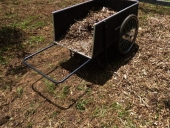
 4
4









Hans Albert Quistorff, LMT projects on permies Hans Massage Qberry Farm magnet therapy gmail hquistorff








"Our ability to change the face of the earth increases at a faster rate than our ability to foresee the consequences of that change"
- L.Charles Birch
My Herbal Tea Store (CA)




 1
1




Moderator, Treatment Free Beekeepers group on Facebook.
https://www.facebook.com/groups/treatmentfreebeekeepers/










"Study books and observe nature; if they do not agree, throw away the books." ~ William A. Albrecht
 1
1




A human being should be able to change a diaper, plan an invasion, butcher a hog, conn a ship, design a building, write a sonnet, balance accounts, build a wall, set a bone, comfort the dying, take orders, give orders, cooperate, act alone, solve equations, analyze a new problem, pitch manure, program a computer, cook a tasty meal, fight efficiently, die gallantly. Specialization is for insects.
-Robert A. Heinlein
 1
1




Chris Kott wrote:Yeah, I agree, James. The described usage sounds more like a living mulch than a cover crop, especially if instead of a chop-and-drop, they are left for intended crops to grow through, perhaps with a little space made.
In this context, I think they'd be great. I mean, what's better than a self-seeding annual or a perennial living mulch or groundcover that also might provide a tasty treat?




Moderator, Treatment Free Beekeepers group on Facebook.
https://www.facebook.com/groups/treatmentfreebeekeepers/





 1
1





 2
2




Kurt Luoto wrote:I have seen many discussion about what to use as a cover crop to help grow strawberries. My problem is different. I have a garden bed mulched with wood chips which the strawberries just love and grow very well in. They seem to want to take over the whole bed! I am wondering whether it would work OK to plant other veggies in with the strawberries, making use of the strawberries as a cover crop to help the veggies grow. The alternative is to pluck out enough strawberry plants to make room for my veggies, but I was wondering whether letting the veggies grow together with the strawberries would be better. The strawberries have such lovely root systems, after all. Are the strawberries good at promoting mycorrhizal fungi?
List of Bryant RedHawk's Epic Soil Series Threads We love visitors, that's why we live in a secluded cabin deep in the woods. "Buzzard's Roost (Asnikiye Heca) Farm." Promoting permaculture to save our planet.




 1
1






 1
1




Cultivate abundance for people, plants and wildlife - Growing with Nature




 4
4




- Tim's Homestead Journal - Purchase a copy of Building a Better World in Your Backyard - Purchase 6 Decks of Permaculture Cards -
- Purchase 12x Decks of Permaculture Cards - Purchase a copy of the SKIP Book - Purchase 12x copies of Building a Better World in your Backyard

|
Yeast devil! Back to the oven that baked you! And take this tiny ad too:
The new gardening playing cards kickstarter is now live!
https://www.kickstarter.com/projects/paulwheaton/garden-cards
|





